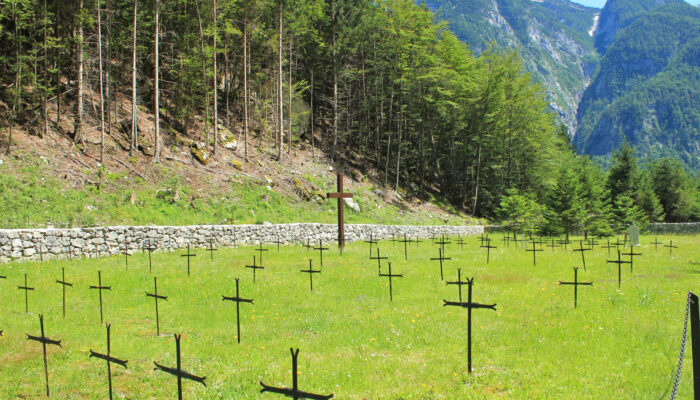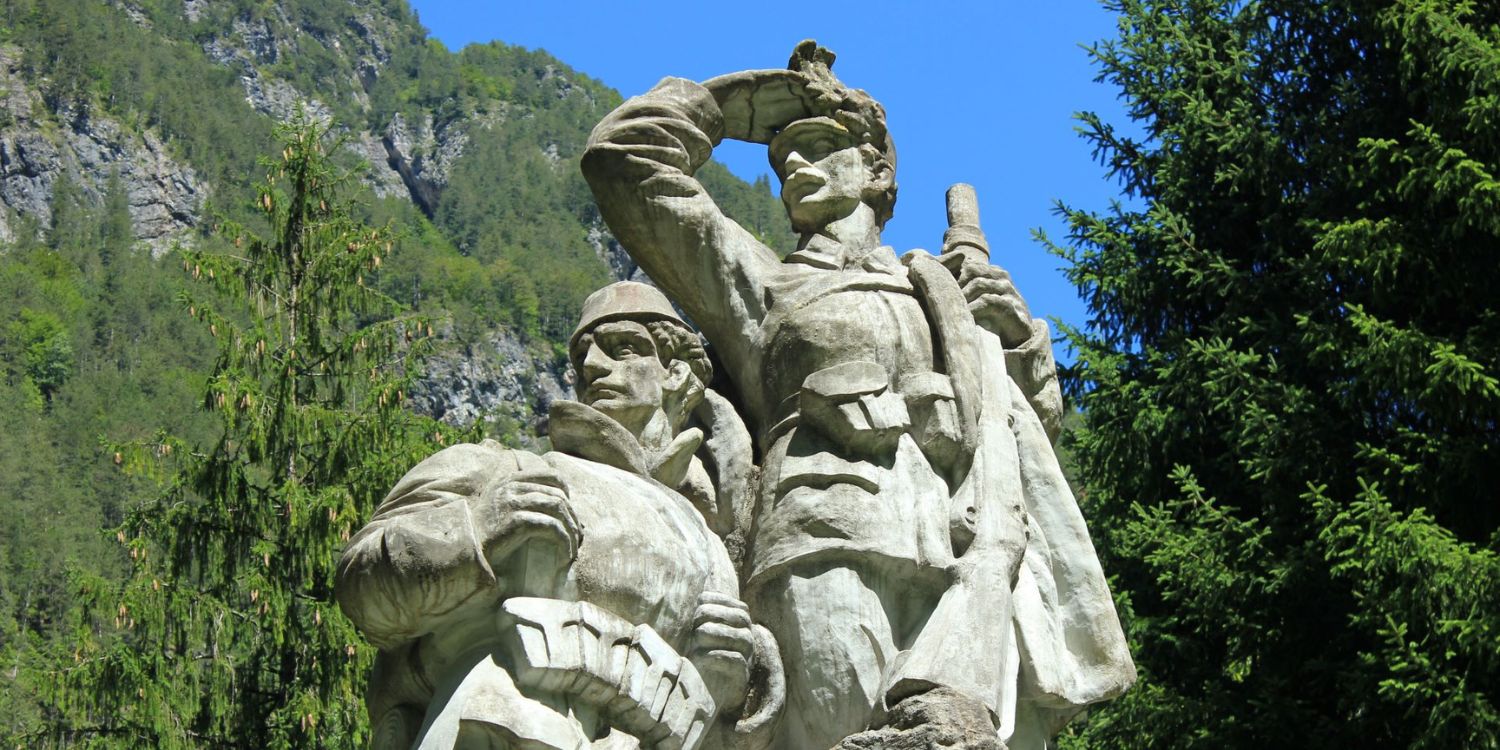
14 Feb Isonzo Front Military Cemeteries in the Soča Valley
For 29 long months of the Isonzo front soldiers were hiding in wet pits, trenches and dark caverns, silently listening to the whistling grenades in hope to survive and return home.
For many, this desire was not fulfilled. And, you may pay your respect to them by visiting one of the cemeteries from the World War 1.

BOVEC
The cemetery is located at the crossroads to Predel and Vršič. 600 soldiers of the Austro-Hungarian army who fell in battles near Bovec and Rombon are buried here. The mortal remains of Italian soldiers were transferred from this cemetery to the Ossuary in Kobarid in 1938.
At the crossroads, opposite the cemetery, there is an obelisk stone pillar, which has the inscription in German and is dedicated to the memory of Austrian soldiers who fell in the years between 1915 and 1917.
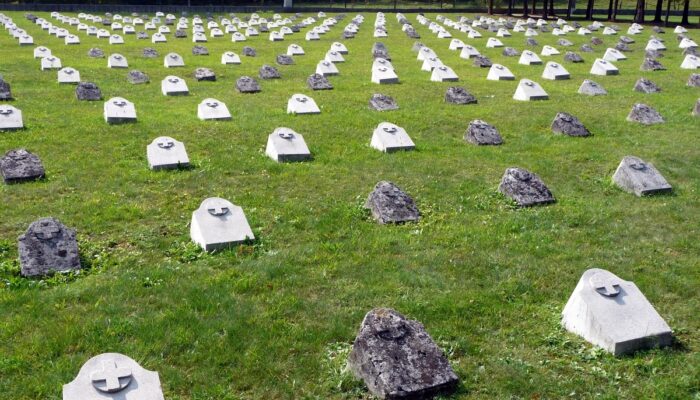
LOG POD MANGARTOM
Behind the church of St. Stephen in Log pod Mangartom, the most beautiful military cemetery in the Soča Valley extends on the four terraces. More than 800 Austro-Hungarian soldiers who defended positions on the slopes of the Mt Rombon in the years 1915-17 are buried here. Rombon was an Austrian rock fortress because the peak of this mountain was an excellent observation point for the entire Soča Valley. For that reason the mountain was a target of regular bombardment and bloody battles.
Among the fallen defenders were many Slovenians, members of the 2nd Mountain Regiment, but most were Muslim Bosniaks, members of the 4th Bosnian-Herzegovinian Infantry Regiment. Their graves do not have iron crosses, but are marked with Muslim tombstones Nišans.
Between the graves stands a Monument to the defenders of Rombon. It was made by Czech sculptor Ladislav Kofránek in 1917, who served as Austro-Hungarian soldier in Log pod Mangartom.
Above the symbolic stone image of the Mt Rombon figures of two soldiers are standing. One is the mountain sharpshooter, who covers his eyes from the sun with his hand. He is equipped for mountain warfare and dressed in the typical uniform. Military sign of his regiment held an image of Zlatorog, the sacred mountain animal. Next to him, stands the Bosnian-Herzegovinian soldier with fes, Muslim hat. Together they stare in the distance towards Mt Rombon, the key pillar of Bovec basin defense.
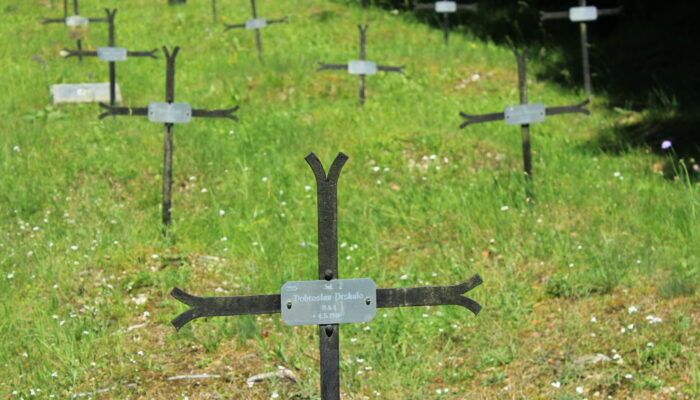
SOČA VILLAGE
Behind the church of St. Joseph in the village of Soča a hospital cemetery is located. More than 1,400 Austro-Hungarian soldiers who died in a military hospital in the village of Soča are buried there.
Soldiers who were wounded in battles were first taken care of by the units of the first aid. These medical units often had to carry out emergency interventions, like amputation, already on the battlefield. Then, the wounded were transferred on stretchers to the military hospitals, where they were examined by doctors.
Many died on the way to hospital. A lot of those who made it to the hospital did not receive adequate treatment as a result of the shortage of medicines and bandages. Often, medical units collected herbs and then prepared home medicines and lotions. Many soldiers died in hospitals due to infections because antibiotics have not yet been in use. The main reason for the infections was lack of hygiene. Therefore, disinfection facility for clothing was standing next to the military hospital in Soča village.
On a slope above the cemetery you can see a cross made of stones. Behind the cross a large rock with built-grenade stands to recall the horrors of war.
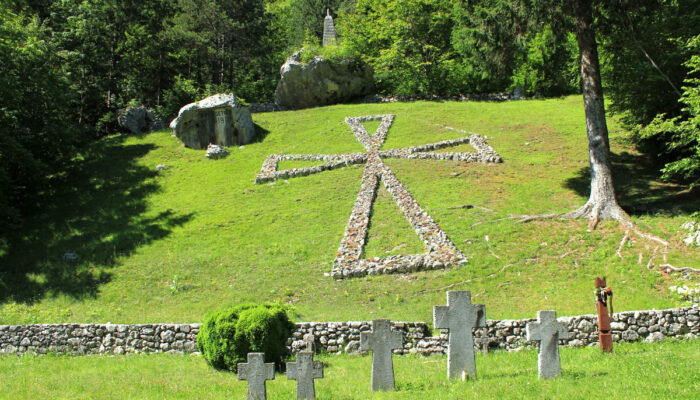
TRENTA
Along the road to Vršič Pass, behind the civilian cemetery, lies another military cemetery on a beautiful green meadow. Here, more than 200 Austro-Hungarian soldiers who died on the Isonzo front are buried.
Among the graves of Austro-Hungarian soldiers are also the graves of Russian prisoners of war who built a road over the Vršič Pass. After Italy entered the First World War, the road over the Predel Pass was no longer safe due to the proximity of the border. Thus, the Austrians began to build the road over the Vršič Pass to supply the Isonzo front.
But they were facing shortage of workers because all healthy men were mobilized on the battlefields. So the Austrians brought 12,000 Russian prisoners of war from the Eastern Front.
They built this road in most inhumane conditions. Most of them died from disease, malnutrition, hypothermia, exhaustion and working accidents. In March 1916 more than 300 Russian prisoners were killed in an avalanche. Russian Chapel and Russian Cross still stand today in memorial to these sad victims.
